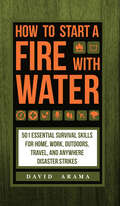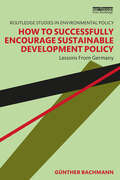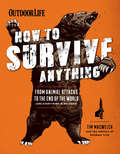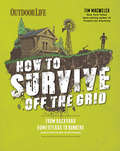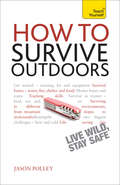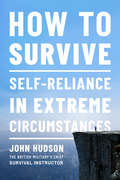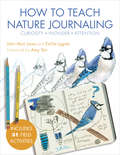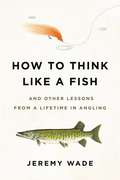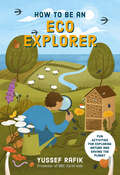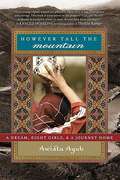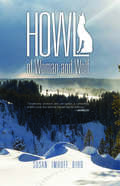- Table View
- List View
How to Speak Flower: A Kid's Guide to Buds, Blooms, and Blossoms
by Molly WilliamsA beautifully illustrated guide to the history and symbolism of flowers for every plant lover. Sunflowers are symbols of friendship. Gardenias represent secrets and mystery. Irises say, I trust you. Flowers bring color and beauty to the everyday world around us, but flowers aren&’t just pretty: Throughout history, they have been used to express ideas about ourselves and the people we care about. From asters to zinnias, from baby&’s breath to forget-me-nots, learn the magical, meaningful language of flowers with this magnificent guide to floriography. The secrets of every bloom and blossom are revealed … and with personalized quizzes and handy charts, you&’ll discover your own flower power!
How to Start a Fire with Water: 501 Essential Survival Skills for Home, Work, Outdoors, Travel, and Anywhere Disaster Strikes
by David AramaLife is unpredictable—are you prepared for it?Should disaster ever strike, you'll feel prepared with this book as your guide. Inside you'll find tips and tricks for surviving unpredictable situations at home, work, outdoors, and while traveling. From natural catastrophes such as lightning strikes, wildfire, floods, earthquakes, and tornadoes to man-made dangers such as car accidents, plane crashes, and electrical fires, this book will help you take the first steps to survival—being prepared.
How to Stay Alive in the Woods: A Complete Guide to Food, Shelter and Self-Preservation Anywhere (In the Woods)
by Bradford AngierHOW TO STAY ALIVE IN THE WOODS is a practical, readable-and potentially indispensable-manual for anyone venturing into the great outdoors. Broken down into four essential sections, Sustenance, Warmth, Orientation and Safety, this enlightening guide reveals how to catch game without a gun, what plants to eat (full-color illustrations of these make identification simple), how to build a warm shelter, make clothing, protect yourself and signal for help. Detailed illustrations and expanded instructions, newly commissioned for this deluxe edition, offer crucial information at a glance, making How to Stay Alive in the Woods truly a lifesaver.
How to Stay Alive: The Ultimate Survival Guide for Any Situation
by Bear GryllsThe ultimate survival guide from Bear Grylls, former Special Forces soldier and #1 world-renowned "King of Survival" (Outside)For more than a decade, Bear Grylls has introduced TV viewers to the most dramatic wilderness survival situations, through his hit shows such as Man Vs. Wild. Now, with How to Stay Alive, Bear reveals to readers his full toolkit of survival tactics, from everyday basics like avoiding blisters to once-in-a-lifetime events like surviving a kidnapping.Opening with the most essential survival skills—assembling your survival kit, making a fire, building a shelter—and then moving on to more specific situations, such as escaping fire, dealing with harsh terrain, and handling medical emergencies, Grylls is a sure guide for any type of disaster situation. Readers will learn how to survive in a life raft, land a helicopter in an emergency, treat hypothermia and frostbite, escape from quicksand, and numerous other lifesaving tips.Richly illustrated with diagrams throughout, How to Stay Alive will be the definitive outdoor survival tome for years to come.
How to Successfully Encourage Sustainable Development Policy: Lessons from Germany (Routledge Studies in Environmental Policy)
by Günther BachmannThis book builds on the insights of Günther Bachmann, former Secretary General for the German Sustainability Council, who spent almost 20 years advising the German government on sustainability policy. The book discusses his experiences in negotiating stakeholder statements at the highest national levels. Bachmann takes the reader behind the scenes of German sustainable policy and practice, whilst also comparing Germany with other national approaches. He tells the story of political events from his insider perspective, unfolding the narrative of sustainable development goals and how activists in their respective countries could and should relate to it. Furthermore, he suggests new lines of vision through the tangle of conference fatigue and buzzwords. The book argues that environmentalists often display entrenched attitudes that too often downplay success. The rhetoric of crisis and doom, if overstretched and reduced to alarm, paralyses action and innovation. Bachmann, who on the contrary argues positively and concretely, shows unusual but significant signs of hope and confidence in action and how these can be made effective in the politics of sustainable development. This book will be of global relevance to sustainability professionals and policy makers and will advise them on how to successfully move ahead with sustainability policies.
How to Survive Almost Anything: The Special Forces Guide to Staying Alive
by Ollie PattonPrepare for Whatever Comes Your Way With This Essential Survival Bible“This book is your essential kit for every aspect of what life can throw at you…Brilliant.” ─Amazon reviewLearn How to Thrive Against All Odds with the Modern Survival Bible from Ex-UK Special Forces specialist Ollie OllertonBe the master of your survival. In How to Survive (Almost) Anything, former Special Forces soldier and bestselling author Ollie Ollerton passes on all the special skills, knowledge, and mindset he’s learned over the course of a life that has experienced some of the world's toughest conditions and most hostile situations.A lifeline in uncertain times. This modern-day survival bible empowers you to thrive, not just survive. Whether you're faced with the wild elements of nature, societal collapse, extreme weather, or urban warfare, this guide equips you with essential skills. Don't leave your survival to chance! Arm yourself with the knowledge and tools to face anything and become the master of your destiny.Inside you'll discover:Survival Techniques: Learn from an ex-UK Special Forces soldier how to fend off wildlife, survive natural disasters, and navigate man-made challengesMental Resilience: Equip yourself with the mindset to thrive, not just survive, in the face of emergencies and against all oddsPractical Guidance: Ideal for survivalists, prepping enthusiasts, or as a thoughtful dad gift or gift for a teen boy, this guide offers hands-on advice to face any crisis with confidence.If you have read books such as The Lost Art of Reading Nature’s Signs, Extreme Survival, Surviving the Wild, or The Ultimate Prepper's Survival Bible, you’ll love Ollie Ollerton’s How to Survive (Almost) Anything.
How to Survive Anything: From Animal Attacks to the End of the World (and Everything in Between) (Outdoor Life)
by Tim MacWelch The Editors of Outdoor LifeThis New York Times bestselling guide covers essential skills and strategies for surviving any catastrophe—from natural disasters to zombies attacks.How to Survive Anything covers situations ranging from the unexpected to the unthinkable, deftly balancing real-life survival know-how with wild scenarios that most likely won&’t ever happen. But, on the other hand, who would you rather have in your bunker? The guy who read up on killer robots or the one who didn&’t? The editors of Outdoor Life magazine cover everything from disaster preparedness to subsistence hunting and fishing, to which guns to use against the undead. After reading the expert advice in this manual, you&’ll be prepared for whatever this world throws at you.
How to Survive Off the Grid: From Backyard Homesteads to Bunkers (and Everything in Between) (Outdoor Life)
by Tim MacWelchThe survival expert and New York Times bestselling author of Prepare for Anything offers a comprehensive, practical guide to self-reliant living. Whether you want to &“go green&” or live the life of a modern-day pioneer, survival expert Tim MacWelch teaches you the knowledge and skills you need in order to unplug successfully. Written from a hands-on perspective, this guide covers everything from raising chickens in your urban backyard to going totally off the grid in your solar-powered log cabin. A guide for the modern homesteader, How to Survive off the Grid contains essential information on energy efficiency, finding and pumping your own water, being your own doctor, keeping chickens, goats, bees, and other critters, and much more.
How to Survive Outdoors: Teach Yourself
by Jason PolleyEvery year, more than 40,000 people climb Mount Kilimanjaro. Millions head for the great outdoors every weekend, and the concept of the Great Outdoors has never been more popular. If you are one of them, would you know what to do if you got stranded or hurt? 'How to Survive Outdoors' gives essential, practical advice for situations that aren't in any way implausible. It starts with ten life-saving tips, then outlines the crucial components - water, food, shelter and so on. It covers scenarios any one of us could encounter, including plane crashes and sinkings.
How to Survive Your First Trip in the Wild: Backpacking for Beginners
by Paul MagnantiThere and back—what every new backpacker needs to know.A journey of a thousand miles starts with a single book. How to Survive Your First Trip in the Wild bundles up everything you need to prep for your first-ever backpacking adventure—so you can explore the backcountry with confidence.Start strong with an essential equipment guide geared toward beginners. Discover how to choose a campsite and follow along with camp setup and breakdown directions. Water treatment info, outdoor cooking basics, snacking suggestions, and a sample three-day backpacking food plan supply you with vital knowledge to survive in the wilderness.This beginners' backpacking handbook includes:Expert tips—Learn how to "Leave No Trace," navigate rough terrain, deal with wildlife, and other practical backpacking advice.Gear checklists—Track down the right gear with guides to clothing, footwear, backpacks, and shelters—even on a budget.Plan ahead—Handy cheat sheets help you pick the best time of year and the perfect starter trail for backpacking in your state.Start your backpacking experience now with How to Survive Your First Trip in the Wild.
How to Survive the Wild (How to Survive)
by Kenny AbdoThis title focuses on the wild and gives information on what it is, how to prepare for it, and how to survive. The title is complete with beautiful and colorful photographs, simple text, and a database for added activities. Aligned to Common Core Standards and correlated to state standards, Bolt! is an imprint of Abdo Zoom, a division of ABDO.
How to Survive: Self-reliance In Extreme Circumstances
by John HudsonGripping stories of near disaster and survival—and the lessons to be gleaned from them—from the British military’s chief survival instructor. When faced with near death, your survival instincts kick in. Instincts can only take you so far, however; it’s preparation and planning that can make the difference between living and dying. In How to Survive, readers will hear harrowing tales of survival and learn from them. These stories are broken down and studied, whether it’s the experience of a teenager hiking to safety as the only survivor of a plane crash in the Peruvian Amazon, a fisherman drifting for more than 400 days in an open boat across the Pacific Ocean, or a US Air Force fighter pilot forced to eject from his stealth fighter thousands of feet above the earth. John Hudson, a military survivor instructor, introduces the mindset that he feels is imperative for success: the Survival Triangle. This combination of effort, hope, and goals, along with a few practical skills, provides a premade planning template that can be used to jumpstart the whole survival process.
How to Take Awesome Photos of Cats
by Andrew MarttilaA fun and practical guide to taking the perfect pics of your cat from the photographer of Cats on Catnip -- a great gift for the feline fanatic in your life. If you or someone you know loves a cat, chances are they love taking pictures of their cat, too. But cats can be tricky little guys to photograph -- they move quickly when you want them to stay still and are sedentary logs when you're going in for an action shot. Add to that all the variables of shooting indoors vs. outdoors, and it can be a difficult job. Enter How to Take Awesome Photos of Cats, where professional cat photographer and popular Instagrammer Andrew Marttila (Cats on Catnip, Shop Cats of New York) walks you through all the steps you need to know to take perfect photos of your favorite feline. This lighthearted, gifty guide includes dozens of photos and shares practical information for both amateur photographers and experts alike, all told in a fun, accessible, and lighthearted way. Whether you're looking to take better photos with your phone or you're trying to master the settings on your digital camera, this is the book that tells you everything you need to know to take awesome snaps of cats.
How to Teach Nature Journaling: Curiosity, Wonder, Attention
by John Muir Laws Emilie LygrenExpanding on the philosophy and methods of The Laws Guide to Nature Drawing and Journaling, John Muir Laws and Emilie Lygren have developed the first-ever comprehensive book devoted to helping educators use nature journaling as an inspiring teaching tool to engage young people with wild places. In their workshops Laws and Lygren are often asked the how-tos of teaching nature journaling: how to manage student groups in the outdoors, teach drawing skills (especially from those who profess to have none), connect journaling to educational standards, and incorporate journaling into longer lessons. This book puts together curriculum plans, advice, and in-the-field experience so that educators of all stripes can leap into journaling with their students. The approaches are designed to work in a range of ecosystems and settings, and are suitable for classroom teachers, outdoor educators, camp counselors, and homeschooling parents. Full-color illustrations and sample journal pages from notable naturalists show how to put each lesson into practice. Field-tested by over a hundred educators, this book includes dozens of activities that easily support the Common Core and the Next Generation Science Standards—and, just as important, it will show kids and mentors alike how to recognize the wonder and intrigue in their midst.
How to Think Like a Fish: And Other Lessons from a Lifetime in Angling
by Jeremy WadeThe star of the Animal Planet's River Monsters and author of the bestselling companion book shares a meditation on fishing--and life.In his previous book, Jeremy Wade memorably recounted his adventures in pursuit of fish of staggering proportions and terrifying demeanor: goliath tigerfish from the Congo, arapaima from the Amazon, "giant devil catfish" from the Himalayan foothills, and more. Now, the greatest angling explorer of his generation returns to delight readers with a book of a different sort, the book he was always destined to write -- the distillation of a life spent fishing.As Jeremy's catches attract increasing attention, many people ask him how they can improve their own fishing results. This book is his reply: part science, part art, and part elusive something else -- which is within every angler's ability to develop. Along the way you will learn when to let instinct override logic, which details are vital and which may be irrelevant, and how a "non result" can be a result. Thoughtful and funny, brimming with wisdom and, above all, adventure, these are pitch-perfect reflections that anyone who has ever fished will identify with, for ultimately they touch on the simple, fundamental principles that apply to all angling -- and to life.
How to be Wild: We are All Wild. it's Just That Civilisation Keeps Getting in the Way
by Simon BarnesWe are all wild. It's just that civilisation keeps getting in the way. And the more civilised we become, the more we need the wild: wild places, wild creatures, and wild experiences. As every one who has patted a dog, smelled a rose, taken a walk, or even had a drink in the garden well knows, humans have a soul-deep need for non-human forms of life. This book is about pushing our birthright of wildness just that little bit further. In "How to be Wild", Barnes takes us on a journey through a year, from one raucous spring to the next - with sparrows and flying squirrels, blackbirds and elephants, badgers, butterflies and mosquitoes, as his companions. And again and again, in myriad different ways, he helps us to realise an essential truth: that by enjoying the wild world, by saving the wild world, by seeking to understand the wild world, our own lives become richer and more satisfying. That is what being wild means.
How to be Wild: We are All Wild. it's Just That Civilisation Keeps Getting in the Way
by Simon BarnesWe are all wild. It's just that civilisation keeps getting in the way. And the more civilised we become, the more we need the wild: wild places, wild creatures, and wild experiences. As every one who has patted a dog, smelled a rose, taken a walk, or even had a drink in the garden well knows, humans have a soul-deep need for non-human forms of life. This book is about pushing our birthright of wildness just that little bit further. In "How to be Wild", Barnes takes us on a journey through a year, from one raucous spring to the next - with sparrows and flying squirrels, blackbirds and elephants, badgers, butterflies and mosquitoes, as his companions. And again and again, in myriad different ways, he helps us to realise an essential truth: that by enjoying the wild world, by saving the wild world, by seeking to understand the wild world, our own lives become richer and more satisfying. That is what being wild means.
How to be a Bad Birdwatcher Anniversary Edition: Embrace the everyday joy of birdwatching – to the greater glory of life
by Simon BarnesTHE BESTSELLING BIRDWATCHING CLASSIC - 20TH ANNIVERSARY EDITION'A delightful ode to the wild world outside the kitchen window - leaves you with the warm feeling that a shared love conquers all.' The Daily Telegraph'A witty, perceptive book; thoughtful, instructive and full of simple wisdom.' The Daily MailLook out the window. See a bird. Enjoy it. CONGRATULATIONS! You are now a bad birdwatcher.Anyone who has ever gazed up at the sky or stared out of the window knows something about birds. In this fun, eye-opening and inspiring book, award-winning nature writer Simon Barnes paints a riveting picture of how birdwatching has framed his life and can help us all to a better understanding of our place on this planet.How to be a Bad Birdwatcher shows why birdwatching is not the preserve of twitchers, but one of the simplest, cheapest and most rewarding pastimes around.
How to be a Bad Birdwatcher: To The Greater Glory Of Life
by Simon BarnesLook out of the window. See a bird. Enjoy it. Congratulations. You are now a bad birdwatcher. Anyone who has ever gazed up at the sky or stared out of the window knows something about birds. In this funny, inspiring, eye-opening book, Simon Barnes paints a riveting picture of how bird-watching has framed his life and can help us all to a better understanding of our place on this planet. How to be a bad birdwatcher shows why birdwatching is not the preserve of twitchers, but one of the simplest, cheapest and most rewarding pastimes around.
How to be a Bad Botanist
by Simon BarnesCan you tell a tomato from a grape? Lawn from an oak tree? Then congratulations - you are a botanist. Self-confessed bad birdwatcher Simon Barnes thought he knew nothing about plants. He didn't object to them: trees are interesting, because birds perch in them; plants are useful as they create habitats and birds live in habitats. But while admiring the tenacity of some sea kale and yellow-horned poppy to thrive on an inhospitable shingle beach, he was struck by a truth - it all begins with plants. In this funny and inspiring book, Simon Barnes tells the story of a lifelong relationship with plants, and the realisation of the fact. Taking us from thinking ourselves ignorant about plants, to gently starting to observe seasons, patterns and places, Barnes guides us on a journey to better observing the beauty and diversity of the natural world. Both a primer on how to appreciate the plants around us and an exploration on how they make our external and interior worlds, How to be a Bad Botanist opens our eyes to the wonders around us. Plants are everywhere, in every part of your life, and you know more than you think.
How to be an Eco Explorer: Fun Activities for Exploring Nature and Saving the Planet
by Yussef RafikThis gorgeously illustrated book invites you on an eco adventure through 10 important ecosystems, with fascinating nature facts and planet-saving activities.You don't need a big garden of fancy equipment to bring about positive changes – all you need is the spirit of an eco explorer: curiosity, respect for nature and a desire to do good. We know that the environment needs our help, but can we really make a difference? Beloved children's presenter Yussef Rafik has made it his mission to share his knowledge about the natural world and the things we can do to help it. How to Be an Eco Explorer introduces you to 10 key ecosystems, from gardens to the coast, and from arid lands to the city. For each one, you will discover:Ecosystem facts: learn about how the ecosystem works, including the challenges it facesSmall solutions: discover little things we can do to help solve these challenges, as individuals or as a societyHabitat heroes: meet under-appreciated animal heroes that are crucial to making the ecosystem work, such as pond snails, cellar spiders and dung beetlesPractical activities: enjoy two step-by-step activities that you can try at home. For example, learn how to make your own rainwater harvester or bathyscope for spying critters underwater! This is the perfect book for young people feeling anxious about the environment, but also for parents looking for inspiring ways to get their children outside, having fun and learning.
How to be an Eco Explorer: Fun Activities for Exploring Nature and Saving the Planet
by Yussef RafikThis gorgeously illustrated book invites you on an eco adventure through 10 important ecosystems, with fascinating nature facts and planet-saving activities.You don't need a big garden of fancy equipment to bring about positive changes – all you need is the spirit of an eco explorer: curiosity, respect for nature and a desire to do good. We know that the environment needs our help, but can we really make a difference? Beloved children's presenter Yussef Rafik has made it his mission to share his knowledge about the natural world and the things we can do to help it. How to Be an Eco Explorer introduces you to 10 key ecosystems, from gardens to the coast, and from arid lands to the city. For each one, you will discover:Ecosystem facts: learn about how the ecosystem works, including the challenges it facesSmall solutions: discover little things we can do to help solve these challenges, as individuals or as a societyHabitat heroes: meet under-appreciated animal heroes that are crucial to making the ecosystem work, such as pond snails, cellar spiders and dung beetlesPractical activities: enjoy two step-by-step activities that you can try at home. For example, learn how to make your own rainwater harvester or bathyscope for spying critters underwater! This is the perfect book for young people feeling anxious about the environment, but also for parents looking for inspiring ways to get their children outside, having fun and learning.
However Tall the Mountain: A Dream, Eight Girls, and a Journey Home
by Awista Ayub"The young Afghan women in However Tall The Mountain are pioneers. Their story is one of resilience and courage. This book is a testament to the power of hope and the will to dream in a country where so many dreams have been cut short." --Khaled Hosseini, bestselling author of The Kite Runner and A Thousand Splendid Suns. "Awista Ayub has movingly captured the indomitable spirit of Afghan women in this chronicle of brave girls who risked persecution and worse to pursue the dreams of ordinary childhood. In doing what they love most in life - playing soccer - the girls become emblems of the fight for equality and human rights under the Taliban. Their story reminds us that there is always hope and possibility for a brighter future - even in the wreckage left by war and conflict. " --Secretary of State Hillary Rodham Clinton A ball can start a revolution. Born in Kabul, Awista Ayub escaped with her family to Connecticut in 1981, when she was two years old, but her connection to her heritage remained strong. An athlete her whole life, she was inspired to start the Afghan Youth Sports Exchange after September 11, 2001, as a way of uniting girls of Afghanistan and giving them hope for their future. She chose soccer because little more than a ball and a field is needed to play; however, the courage it would take for girls in Afghanistan to do this would have to be tremendous--and the social change it could bring about by making a loud and clear statement for Afghan women was enough to convince Awista that it was possible, and even necessary. Under Taliban rule, girls in Afghanistan couldn't play outside of their homes, let alone participate in a sport on a team. So, Awista brought eight girls from Afghanistan to the United States for a soccer clinic, in the hope of not only teaching them the sport, but also instilling confidence and a belief in their self-worth. They returned to Afghanistan and spread their interest in playing soccer; when Awista traveled there to host another clinic, hundreds of girls turned out to participate--and the numbers of players and teams keep growing. What began with eight young women has now exploded into something of a phenomenon. Fifteen teams now compete in the Afghanistan Football Federation, with hundreds of girls participating. Against all odds and fear, these girls decided to come together and play a sport that has reintroduced the very traits that decades of war had cruelly stripped away from them--confidence and self-worth. In However Tall the Mountain, Awista tells both her own story and the deeply moving stories of the eight original girls, describing their daily lives back in Afghanistan, and how they found strength in each other, in teamwork, and in themselves--taking impossible risks to obtain freedoms we take for granted. This is a story about hope, about what home is, and in the end, about determination. As the Afghan proverb says, However tall the mountain, there's always a road.
Howl
by Susan Imhoff Bird"With humor, sensitivity, and probing intelligence, Bird's inquiry into the world of the wolf weaves an outer journey with inner way-finding, resulting in an inspiring book about being more than human--it's about being alive."--Mary Ellen Hannibal, author of The Spine of the Continent: The Race to Save America's Last, Best WildernessCommemorating the twentieth anniversary of the reintroduction of wolves to the American West, Howl follows Susan Imhoff Bird's exploration into the passions and controversies surrounding nature's most fascinating predator. At a crossroads in her own life, Bird travels around the West, talking with wolf watchers, landowners, wildlife managers, conservationists, and hunters about their understandings of what matters most, which almost always is their connection with the natural world. However, the often-conflicting issues raised by hunters, ranchers, and politicians prompt Bird's personal examination of wolf science, myths, and ethics, culminating in her conviction that wolves must be allowed to recover and thrive on our lands. Along the way, Bird begins to unleash her own wild nature, learning to howl and inviting us to do the same.Susan Imhoff Bird finds inspiration in Utah's canyons, valleys, and water-sculpted rock. She can often be found on her bicycle or snowshoes, absorbing the wisdom of the natural world. Bird lives in Salt Lake City, Utah.
Hubcaps and Puppies
by Rosemary NelsonIt’s not easy having your own father for a teacher, but that’s only one of twelve-year-old Nikki’s problems. Her beloved dog has died, leaving a gaping hole in her life, which is thrown into further turmoil by the arrival of her long-lost eccentric grandmother from Australia. Life is pretty tense around Nikki’s house, but Nikki relaxes by taking long rides on her horse and visiting a nearby secluded pond inhabited by a rare species of turtle. Things do begin to get brighter when she receives an unwanted, runt puppy as a birthday present. She names the ugly little Border Collie Lucky and he flourishes under her care. As she and her grandmother begin working together, first of all at preparing a garden and then at training Lucky for the local agility trials, they eventually become friends and the grandmother begins telling Nikki about her crusades for the environment in Australia. When Nikki finds out that developers are planning to fill in her special pond to build a housing estate, wiping out the turtles’ habitat, she decides to take a dangerous stand on the animals’ behalf. But can she really take on a big developer and win? Hubcaps and Puppies is not only a story about a girl, her dog and her horse, but also about the protection of the environment and the lessons that the older generation may have to teach the younger if they are willing to listen. Nelson writes in a fast-moving and energetic style, but her characters and situations are always realistic and believable.

